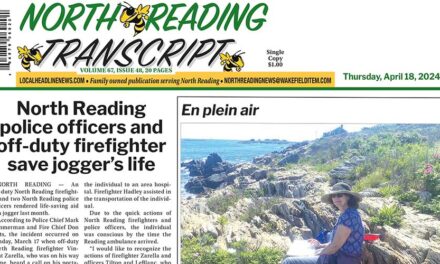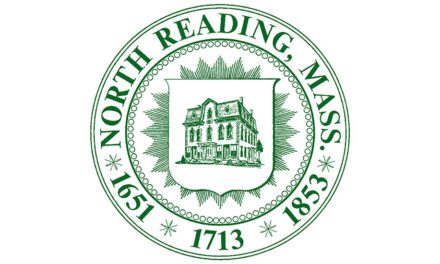Published in the April 19, 2018 edition
By MAUREEN DOHERTY
NORTH READING—In the end, it all comes down to building relationships.
During his tenure of nearly 20 years, Town Engineer Michael Soraghan learned that the strength of the relationships he built with the townspeople he served, his colleagues at Town Hall, his peers in the field as well as the applicants seeking approval for their projects were equally important to the foundation of his work.
Building upon those foundations enabled him to work in partnership with others, whether people or bureaucratic agencies, to create the optimal result under the given circumstances.
And no one can work in one job for two decades without developing a cast of all-star characters and local color who make the job worthwhile.
This is especially true when your job involves helping people in the midst of a crisis situation, such as when their homes are threatened by rising flood waters during significant storms or when vulnerabilities are discovered as a result of a nearby subdivision project that they fear will overtax a culvert down the street — potentially negatively impacting their home and business.
Among the first townspeople Soraghan met back in 1998 were residents of the Martins Pond neighborhood who were actively involved in monitoring activities that impacted the pond and made it more vulnerable to flooding its banks and overflowing into yards and homes or making the roads impassable.
Two people who stand out in his mind are former resident Paul Cameron and the late Danny Morrow, both of whom actively monitored the water level of the pond on a regular basis. “I really depended on Dan and Paul; they were like my assistants,” he said.
“Neither one wanted the pond to flood out because their houses were affected. They would go up and down Martins Brook. They’d tell me: ‘Mike, there’s a beaver dam. Mike, there’s a blockage, you got to go down to Benevento’s and let them know.’ And they were right. They were my eyes and ears of what was going on in that neighborhood, and it really saved me a lot of time from driving down there on a daily basis responding to complaints. If I got a complaint from somebody else at the pond I could say, ‘I’m aware of the situation, we’re working on it and we’re going to get it resolved,’” he said.
While their initial encounters stemmed from their need to ensure a town official helped solve a problem — a relationship that can turn adversarial under certain situations — Soraghan had a way of dealing with people and producing the results that ensured mutual respect, and even friendship, would develop instead.
“They’d send me jokes,” he recalled, adding, “I had my own special email folder for Danny Morrow.”
“The pond has not flooded out for a few years, but there is a whole different cast of characters down there now. Once the pond floods out, and it is going to some day, my successor will be indoctrinated into the complaints from the pond. The Martins Pond Association has always been very active. Janet (Nicosia) is still involved but not to the extent that she was, but somebody else will step up.”
Burying the wires
Soraghan is also proud of his involvement in helping to secure the grant funds that enabled the cobweb of overhead wires that once marred the sight lines of the town common at Haverhill and Park streets to be buried underground.
This was done in conjunction with the rebuilding of Route 62 by the state, from Kitty’s to the Middleton town line, in the early 2000s.
And it also provided him with the opportunity to work closely with other town activists involved in historic preservation — Pat Romeo and Barbara Neiley.
“They were the proponents of putting underground utilities in the town center,” he recalled, as was his former boss, retired DPW Director Dave Hanlon. “I think we did a good job for the town and the project really turned out better than I could have imagined at the start of it. I was just happy to be a part of it.”
It was achieved through an old PWED grant which stood for Public Works Economic Development. He laughs as he recalled the basis used for the “economic development” component of the grant for this area of town was the Hornet’s Nest, the Center Cut barber shop and Ryer’s store. Unlike most towns, North Reading’s business center is not based it the center of town. While this fact enabled the town common to retain its pastoral roots, with the exception of that cluster of ugly wires, cables and telephone poles. As a result of this grant, in addition to burying the wires, the ugly wooden telephone poles were replaced with decorative old fashioned street lamps, the design of which was incorporated into the traffic lights at both Ryer’s and Freedom Drive.
“We were responsible for the construction administration” of the Route 62 project for the town, he said, referring to himself and Al DiSalvo, who was that time was the assistant engineer and is now the assistant building inspector. Much of their work on the roadway project itself involved serving as liaisons between the town’s residents and the state throughout the roadway widening project, which involved a multitude of right of way issues— especially the taking down of tree canopies — to make way for the wider road, sidewalks and curbing, drainage installation, building of large retaining walls and the aforementioned traffic lights. It also involved a multi-year rebuilding of the Washington Street bridge, which at times was just one lane wide, controlled by a temporary traffic lights.
In addition to special projects like road reconstruction, which come along once in a generation or two, as town engineer Soraghan said, “My charge dealt with roadways, drainage systems and stormwater permitting. I always got involved with trees — tree complaints and a lot of it had to do with locating the tree if it was in the town’s right of way, if they were a public tree. And then dealing with all the laws affecting public trees such as tree hearings.
“Dealing with flooding issues was a constant, and improving our drainage systems through hazard mitigation grants and some local funds as well,” he said.
The quality of stormwater, once it exits these drainage systems, is better today than it was 20 years ago. “It has a lot to do with meeting permitting requirements under NPDES permits, and it’s promulgated by the EPA and we’re obligated to meet the requirements that they set up,” Soraghan said.
“We went through our first permit with them, it was a five-year permit, and here we are 13 years later and they’re about to issue their second five-year permit,” he said. Only in government can a five-year permit turn into a 13-year process!
These permits are issued to the state, he said, and the town is required to put together a stormwater management plan which entails “all the activities that they require you do to improve the quality of stormwater before it hits the Ipswich River or Martins Pond or our water bodies,” he said.
The town is also involved in long-term planning for the effects of an ever changing climate and the hazards related to those changes.
Soraghan said, “We recently got a grant from the state, an MVP grant. It stands for Municipal Vulnerability Preparedness. They look at the duration and the frequency of these storm events and how they’re going to increase in frequency. Knock on wood, we haven’t had a flooding in the pond area for a few years. But this planning grant will give the town an opportunity to look at their future vulnerabilities and start reacting now for something that may be 20 years out or 30 years out.”
He said they recently held a few workshops with the Emergency Management Director Theo Kuliopulos, Town Planner Danielle McKnight, Utilities Director/Acting DPW Director Mark Clark, and some residents from the Martins Pond area to prepare for this planning grant.
“That’s something I think the town should look to lay out a footprint of where we’d be in 20 years when you have a late winter storm with a lot of heavy, wet snow. You look at all the vulnerabilities and try to plan to mitigate storms like that.” He is confident that the transition on such projects will be seamless for his successor because of the team approach they use in getting multiple departments involved in projects, particularly those with long horizons.
Soraghan enjoyed working with all of his colleagues over the years, including Town Administrators Tom Younger, Greg Balukonis and Mike Gilleberto; DPW Directors Dave Hanlon, Dick Carnevale and Andrew Lafferty, the front office staff at the DPW and all of the guys in the DPW, many of whom have retired, like Fran Pothier, Lou Ferratusco and Richie Mosack, and so many others too numerous to mention.
But he gave a special shout out to Utilities Superintendent Mark Clark, whom he described as “a rock” and a solid individual from his first day on the job to his last.
What’s next for Soraghan? He is very much looking forward to spending more time with his wife Marie, who is a retired elementary school teacher, and their children, James and Katey, as well as their two grandsons, Thomas, 9 and Joseph, 8. Now that he is retired, there will be plenty of time for pursuing their interests in golfing, fishing and traveling. While he prefers saltwater fishing, don’t be surprised if you see him taking his grandsons to the annual fishing derby held at Martins Pond!





